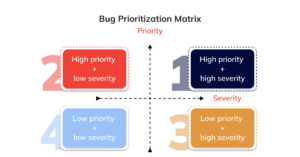In software development, clear and effective bug reporting plays an important role in the success of a product. A well-written bug report is an important communication tool between testers and developers, ensuring that problems are quickly understood and corrected. On the other hand, a poorly written report can cause confusion, waste time, and slow down a project. When testers master the art of writing precise and informative bug reports, they help developers to fix problems more efficiently, resulting in faster releases and higher-quality software.
In this blog, we’ll cover why effective bug reporting is important, the key components of a great bug report, and how to avoid common mistakes.
Why Effective Bug Reporting is Important
Clear Communication Between Teams
Testers and developers have different roles in the project; testers find problems, while developers focus on fixing them. Because they often approach the code from different perspectives, bug reports serve as an important communication tool between the two. Writing a clear and concise report keeps everyone on the same page, making it easier for both teams to understand and address the issue.
Faster Bug Resolution
The clearer and more detailed the bug report, the easier it is for developers to identify a problem. When key information is missing or unclear in reports, teams often go back and forth unnecessarily, slowing down the process. Well-written bug reports help developers resolve issues more efficiently.
Improved Project Efficiency
Clear and complete bug reporting plays an important role in enhancing project efficiency. When issues are well documented and there are step-by-step instructions for reproduction, teams can collaborate more effectively, avoiding confusion. This is especially important in Agile environments, where short sprints and tight timelines make every moment count.
Minimized Back-and-Forth
When bug reports are incomplete or unclear, developers should generally ask testers for more information. This back-and-forth wastes time and can be frustrating for both teams. By providing all relevant information from the start, testers can reduce the need for follow-up questions and speed up the process.

Key Components of an Effective Bug Report
A well-written bug report contains several key features that help the development team in identifying and fixing the issue. Below are the important components that should be part of any bug report:
Clear and Concise Title
The title of the bug report should summarize the topic as clearly and concisely as possible. A good title helps developers quickly understand what the problem is without having to read the entire report.
Example: “Login Button Becomes Unresponsive After 3 Failed Login Attempts”
Detailed Description of the Bug
The description should explain the issue in detail, outlining the expected behavior vs the actual behavior. Providing context for why the bug is a problem can help developers prioritize it appropriately.
Example: “After entering incorrect login credentials three times, the login button becomes unresponsive. This prevents users from trying again without refreshing the page.”
Steps to Reproduce
One of the most important parts of the bug report is the step-by-step instructions for recreating the issue. The steps should be clear, precise, and easy to follow, ensuring that developers can duplicate the bug on their own.
- Example:
- Go to the login page.
- Enter invalid login credentials (username: test, password: test).
- Click the “Login” button.
- Repeat steps 2 and 3 three times.
- Note that the login button does not work on the third attempt.
Environment Details
It is important to include information about the environment where the error was found, such as browser version, operating system, device type, and network status. Bugs may occur only under certain configurations, so specifying the environmental data helps developers accurately map the issue.
Example: “Tested on Chrome v93, Windows 10, 64-bit.”
Screenshots and Video Attachments
Pictures can say more than words, especially in bug reporting. Including screenshots or short videos that showcase the issue gives developers a clear idea of the issue and reduces the chances of miscommunication. Highlight the bug in the screenshots or videos to ensure clarity.
Severity and Priority
Bug reports Classify the bug based on its severity and priority. Severity refers to the impact of the bug on the system, while priority refers to how urgent it is to fix.
Severity: Critical, High, Medium, Low
Priority: Immediate, High, Medium, Low
Example: “Severity: High, Priority: Immediate.”

Bug Reproducibility
Indicate how frequently the bug occurs, such as “Always” or “Sometimes.” This information is essential because it helps developers understand the extent of the issue and whether it can be reliably reproduced.
Common Mistakes to Avoid in Bug Reporting
Vague Descriptions
Avoid vague explanations that do not explain the matter clearly, such as “The app crashed” or “Something went wrong”. Such cases lack precision and do not provide enough information for developers to correctly diagnose the problem. A clear and precise explanation is essential for the topic to be understood and dealt with quickly.
Inadequate Steps to Reproduce
When the steps to reproduce a bug are incomplete or unclear, it can be challenging for developers to replicate the issue. It’s important to give clear and well-structured instructions. By providing detailed steps, developers can easily see how to reproduce the bug, which helps them diagnose and fix the issue more quickly.
Missing Environment Details
Failing to include information about the environment where the bug was discovered can lead to misunderstandings for developers, particularly if the issue arises only under certain conditions. Providing details such as browser version, operating system, device type, and network settings is crucial for accurately replicating the bug.
Assigning Incorrect Priorities
Giving bugs the wrong priority can lead to confusion and slow down the development process. If every bug is labeled as “high priority” without careful thought, developers might get overloaded and miss the most critical issues. It’s crucial to assess how quickly each bug needs to be fixed and assign the right priority to ensure the most serious problems are handled first.
Best Practices for Testers in Bug Reporting
Be Objective and Respectful
When writing bug reports, focus on facts, not opinions. Avoid assigning blame or using emotional language. The aim is to work collaboratively with developers, not to criticize their work.
Use a bug report template
Many tracking systems like Jira, GitHub, and Bugzilla provide templates for bug reporting. Using a consistent approach ensures that all important information is captured, simplifying the process for testers and developers.
Test Thoroughly Before Reporting
Before submitting a bug report, make sure the issue is reproducible and not caused by outside factors like network issues or unrelated system errors. This helps prevent unnecessary reports and confusion.
Focus on Critical Bugs First
Although all bugs are important, it’s essential to report critical issues first, particularly those that affect core functionality or could cause serious problems for users.
Tools That Can Improve Bug Reporting
Jira, Trello, or Asana
These popular project management tools help keep bug reports organized and easy to track. Testers can document bugs, assign priorities, and monitor progress throughout the development lifecycle.
Browser Developer Tools
Testers can use Chrome or Firefox developer to inspect page elements, capture console errors, and gather network activity logs, providing detailed information for developers.
Screen Recording Software
Tools like Loom or OBS Studio allow testers to capture video evidence of bugs, which can be especially helpful for demonstrating issues that are difficult to explain in writing.
Postman and Charles Proxy
For API-related bugs, tools like Postman can help testers capture request/response logs, while Charles Proxy can monitor network activity, making it easier to identify backend issues.
Conclusion
Effective bug reporting is essential to smooth collaboration between testers and developers. By providing clear, detailed, and actionable defect reports, testers can facilitate rapid troubleshooting and improve overall product quality. Testers should include all necessary information in their reports, avoid common mistakes, and maintain objective and respectful communication with developers. With proper bug reporting, teams can bridge the gap between testing and development, resulting in a more efficient and productive software development process.




